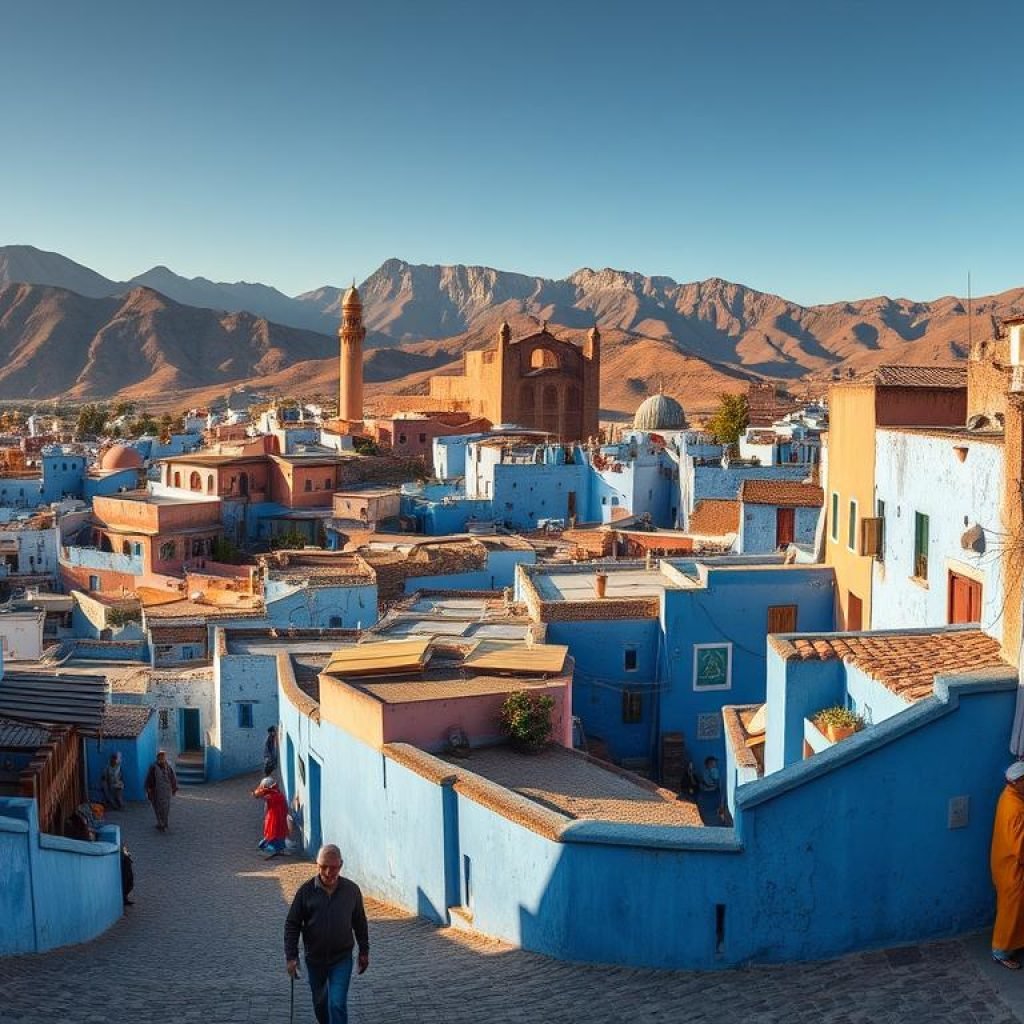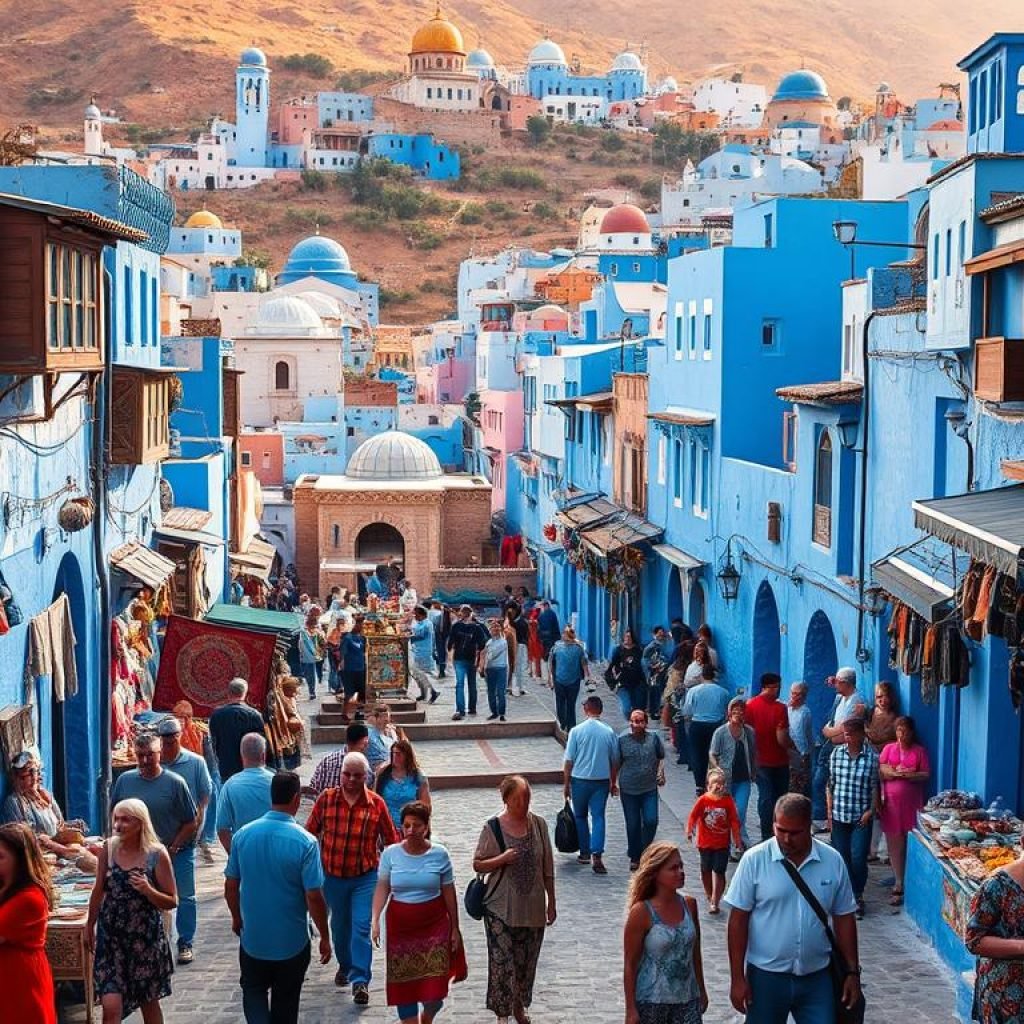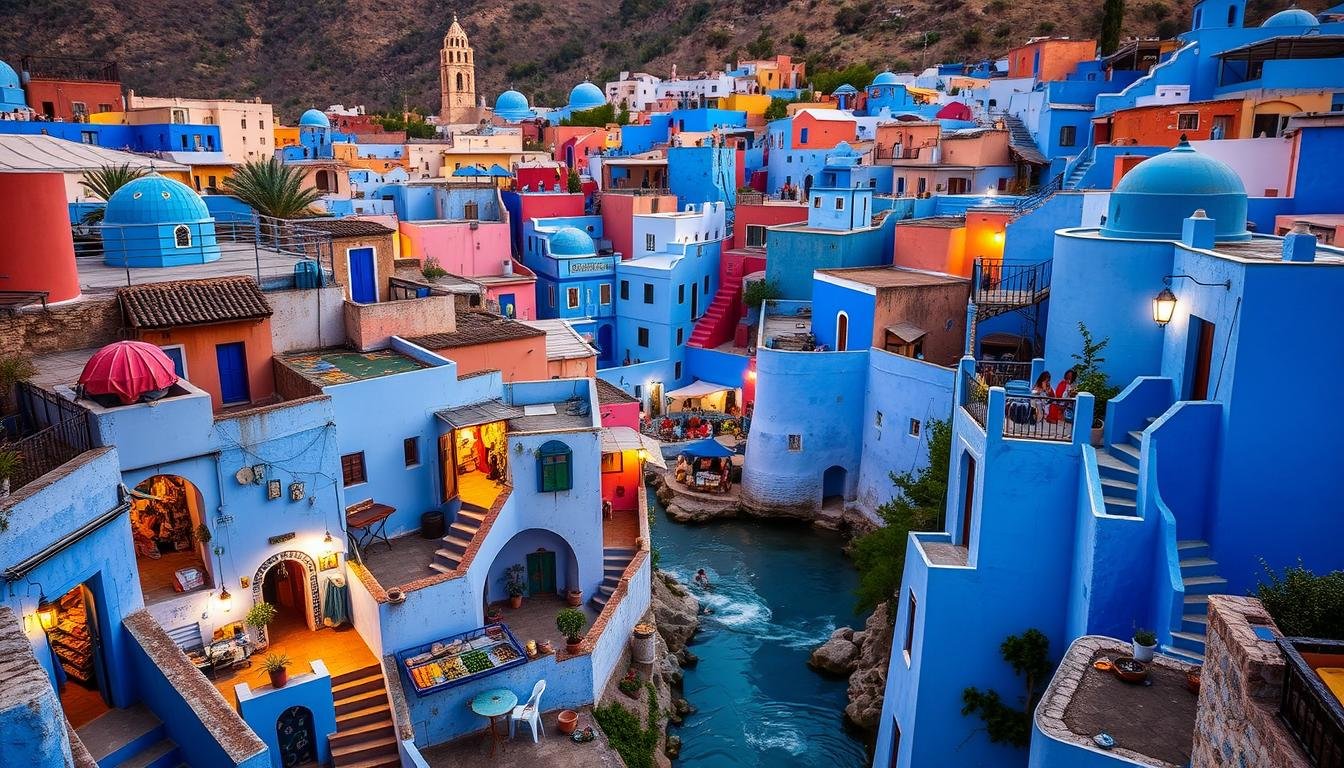Have you ever wondered what makes a city truly unforgettable? Nestled in the Rif Mountains of Morocco, Chefchaouen offers an answer with its mesmerizing blue-painted streets and buildings. This unique aesthetic has earned it the nickname “The Blue City,” setting it apart from other destinations in the region.
Founded in the 15th century, this picturesque town was initially a fortress to protect against invasions. Over time, it evolved into a cultural hub, blending history, tradition, and natural beauty. The calming blue hues are believed to have been introduced by Jewish refugees, symbolizing peace and spirituality.
Unlike bustling cities like Marrakech or Fes, Chefchaouen offers a tranquil escape. Its medina is one of the cleanest in Morocco, and the surrounding mountains provide stunning hiking opportunities. Whether you’re exploring the kasbah, visiting the Spanish Mosque, or simply wandering the blue alleyways, every corner tells a story.
This guide will help you uncover the secrets of Chefchaouen, from its rich history to practical tips for your visit. Ready to dive into the charm of Morocco’s Blue City? Let’s begin.
Key Takeaways
- Chefchaouen is known as “The Blue City” due to its iconic blue-painted buildings.
- Located in the Rif Mountains, it offers a peaceful retreat compared to busier Moroccan cities.
- The blue color is believed to have been introduced by Jewish refugees, symbolizing peace.
- Explore historical sites like the kasbah and the Spanish Mosque.
- Perfect for hiking, with trails leading to the Rif Mountains and Talassemtane National Park.
- Discover local culture, cuisine, and unique accommodations during your stay.
Overview of Chefchaouen: Morocco’s Blue City
Step into a world where every corner feels like a painting. This quaint town is famous for its vivid blue alleys and medina, creating a serene and photogenic atmosphere. The unique color scheme transforms the place into a calming retreat, perfect for those seeking peace and beauty.
The best time to visit is during spring or fall, when the weather is mild and the scenery is at its most vibrant. These seasons allow you to fully enjoy the medina’s charm and the surrounding natural beauty without the summer crowds.
Unlike larger Moroccan cities, this city offers a tranquil escape. Its medina is clean and welcoming, with friendly locals adding to the relaxed vibe. Whether you’re exploring the blue alleyways or soaking in the mountain views, every moment feels special.
This overview sets the stage for deeper insights into the history, culture, and practical tips for your visit. Get ready to immerse yourself in the magic of Morocco’s Blue City.
History and Culture Behind the Blue City
Every city has a story, but few are as colorful as this one. The iconic blue walls of this town are more than just a visual treat—they are a testament to its rich history and cultural heritage. From the influence of Jewish refugees to the marks of colonial rule, each layer adds depth to its identity.

Jewish Influence on the Blue Aesthetic
The origins of the blue color can be traced back to the 15th century. Jewish refugees fleeing persecution in Spain sought safety here. They brought with them the tradition of painting buildings blue, a practice believed to symbolize peace and spirituality. Over time, this custom became a defining feature of the town.
For many, the blue walls are more than just a thing of beauty. They represent resilience and hope, a reminder of the people who found sanctuary here. Today, the vibrant hues continue to inspire visitors from around the world.
Colonial Legacy and Local Traditions
The town’s history is also shaped by its colonial past. In the early 20th century, it became part of Spanish Morocco. This period left its mark on the architecture and culture, blending European influences with traditional Moroccan elements.
Despite these changes, the town has retained its unique character. Local traditions, from craftsmanship to cuisine, reflect a blend of Berber, Jewish, and Moorish heritage. Unlike the bustling streets of Marrakech, this place offers a quieter, more introspective experience.
As one travel blog notes, “The blue walls are not just a backdrop—they are a living part of the town’s story.” Whether you’re exploring the medina or hiking in the nearby mountains, every step reveals a new chapter in this captivating tale.
Getting to Chefchaouen
Reaching this picturesque town is an adventure in itself. Unlike larger cities, it doesn’t have a nearby airport or train station. This means your journey will primarily involve road travel, with buses and taxis being the most common options.
Travel Options from Tangier and Fes
If you’re starting from Tangier, the trip takes about 2.5 hours by car or 2 hours and 45 minutes by bus. Buses are affordable, with tickets costing around $6, but it’s wise to book in advance due to limited daily services.
From Fes, the journey is slightly longer, taking approximately 4 hours by bus or 3 hours by car. Bus tickets from Fes cost around $11, and like Tangier, services are limited, so planning ahead is essential.
Navigating Local Transportation
Once you arrive, navigating the town requires a bit of planning. The medina is a walking-only area, so you’ll need to walk or take a taxi from the bus station. Taxis are readily available, but it’s helpful to confirm the fare and destination beforehand.
Keep in mind that the streets are narrow and winding, so having a clear route in mind will save time. If you’re hiring a private taxi, negotiate the fare in advance to avoid surprises.
| Starting Point | Travel Time | Cost (Bus) | Cost (Taxi) |
|---|---|---|---|
| Tangier | 2.5 hours | $6 | $9 per person |
| Fes | 4 hours | $11 | $60 per vehicle |
Whether you choose a bus or taxi, the journey is part of the experience. With a bit of preparation, you’ll arrive ready to explore this unique destination.
Where to Stay in Chefchaouen
Finding the perfect place to stay can make your trip unforgettable. This charming town offers a variety of accommodations, from budget-friendly riads to unique local stays. Whether you’re looking for affordability or an authentic experience, there’s something for everyone.
Affordable Riads and Hotels
For budget-conscious travelers, riads and small hotels are the best options. These accommodations often feature traditional Moroccan decor and rooftop terraces with stunning views. Prices typically range from $30 to $60 per night, making them an excellent choice for those looking to save without sacrificing comfort.
Popular options include Hotel Souika and Riad Gharnata, both known for their central locations and excellent value. Booking in advance is recommended to secure the best price and availability.
Unique Local Accommodation Experiences
If you’re seeking something special, consider staying in a traditional riad or a boutique guesthouse. These places often offer unique features like handcrafted interiors, private courtyards, and panoramic views of the blue medina.
For a luxurious experience, Dar Jasmine is a top choice. It features spacious rooms, an outdoor pool, and breathtaking mountain views. Alternatively, Casa Sabila offers a rooftop terrace that’s perfect for enjoying the sunset.
| Accommodation | Price Range (per night) | Special Features |
|---|---|---|
| Hotel Souika | $30 – $40 | Budget-friendly, central location |
| Riad Gharnata | $40 – $50 | Traditional decor, excellent breakfast |
| Dar Jasmine | $100 – $150 | Luxury, outdoor pool, mountain views |
| Casa Sabila | $80 – $100 | Rooftop terrace, panoramic views |
To get the best deals, compare options on reputable booking sites. This will help you spot hidden gems and secure your ideal stay. Whether you choose a budget-friendly hotel or a luxurious riad, your accommodation will enhance your visit to this enchanting town.
Top Things to Do in Chefchaouen
Discover the magic of a town where every corner tells a story. From its iconic blue alleyways to its stunning natural surroundings, this destination offers a mix of cultural exploration and outdoor adventures. Whether you’re a history enthusiast or a nature lover, there’s something for everyone.

Exploring the Medina and Blue Alleyways
Start your journey with a leisurely stroll through the medina. The vibrant blue walls create a serene atmosphere, perfect for photography or simply soaking in the charm. Narrow streets lead to hidden gems, from local shops to cozy cafés.
Don’t miss the chance to interact with friendly locals. They often share fascinating stories about the town’s history and traditions. The medina is also home to the Kasbah, a historic fortress worth exploring.
Hiking in the Rif Mountains
For outdoor enthusiasts, a day trip to the Rif Mountains is a must. The trails offer breathtaking views of the surrounding landscape, making it a perfect escape for nature lovers. Popular routes include hikes to Jebel Lakraa and the Akchour Waterfalls.
These trails cater to all skill levels, from beginners to experienced hikers. Remember to bring comfortable shoes and plenty of water for your adventure.
Sunset Views at the Spanish Mosque
End your day with a visit to the Spanish Mosque. Perched on a hill, it offers panoramic views of the town and the mountains. The sunset here is unforgettable, painting the sky in vibrant hues.
The hike to the mosque takes about 30 minutes and is relatively easy. It’s a popular spot for photographers and anyone looking to unwind after a day of exploration.
Whether you’re wandering the medina, hiking in the Rif Mountains, or enjoying the sunset, this town promises an unforgettable experience. Plan your visit to make the most of its unique charm.
Local Cuisine and Dining Experiences
Food is the heart of any culture, and this town is no exception. The culinary scene here is a blend of traditional Moroccan flavors and contemporary café experiences. Whether you’re a foodie or a casual diner, the local dishes and vibrant dining spots will leave you craving more.
Traditional Moroccan Flavors
Moroccan cuisine is a feast for the senses. From aromatic tagines to fluffy couscous, every dish is a celebration of spices and flavors. Local restaurants like Casa Hassan and Restaurant Beldi Bab Ssour are known for their authentic meals. Don’t miss the chance to try pastilla, a savory pastry filled with meat and spices.
As one local chef puts it,
“Our food is more than sustenance—it’s a way of sharing our heritage.”
Dining here is not just about eating; it’s about experiencing the culture.
Best Cafés and Dining Spots
For a more relaxed vibe, explore the town’s charming cafés. Café Clock is a favorite among both locals and tourists, offering a mix of traditional and modern dishes. Their rooftop terrace provides stunning views of the medina, making it a perfect spot for a leisurely meal.
If you’re in the mood for something sweet, visit Patisserie Laayoune. Known for its Moroccan pastries, this shop is a must-visit during Ramadan when the variety of treats increases significantly.
| Dining Spot | Specialty | Highlights |
|---|---|---|
| Casa Hassan | Tagine | Authentic Moroccan flavors |
| Café Clock | Fusion dishes | Rooftop terrace with medina views |
| Patisserie Laayoune | Pastries | Best during Ramadan |
For a deeper dive into the culinary scene, consider joining a guided food tour. These tours take you to more than six stops, offering a taste of everything from street food to gourmet dishes. They’re a great way to explore the medina’s hidden gems while learning about the history behind each dish.
As you wander the narrow streets, you’ll find that dining often complements shopping for local handicrafts. The medina’s vibrant area is perfect for picking up souvenirs while enjoying a meal. Whether you’re savoring a tagine or sipping mint tea, every bite and every moment is a celebration of this town’s rich culture.
chefchaouen travel guide
To make the most of your visit, crafting a well-structured itinerary is key. This charming town offers a mix of iconic landmarks and hidden gems, ensuring every day is filled with discovery. Whether you’re exploring the vibrant medina or hiking in the surrounding mountains, a clear plan helps you experience it all.
Mapping Out Your Itinerary
Start by dedicating a day to wandering the medina’s blue-painted streets. Spend a few minutes at each corner to soak in the serene atmosphere and capture stunning photos. Don’t rush—this is the best way to uncover hidden spots like local shops and cozy cafés.
For outdoor enthusiasts, allocate another day for hiking in the Rif Mountains. Popular trails include the Akchour Waterfalls and Jebel Lakraa. These routes offer breathtaking views and are suitable for all skill levels.
Balancing Activities and Relaxation
While sightseeing is a must, leave room for spontaneous exploration. A leisurely trip to the Spanish Mosque is perfect for sunset views. The hike takes about 30 minutes and rewards you with panoramic vistas of the town and mountains.
Balance your schedule with time for local dining. Try traditional dishes like tagine or pastilla at Casa Hassan or enjoy a relaxed meal at Café Clock. These spots offer a taste of the town’s vibrant culinary scene.
| Activity | Time Required | Highlights |
|---|---|---|
| Medina Exploration | Half a day | Blue streets, local shops, Kasbah |
| Hiking in Rif Mountains | Full day | Akchour Waterfalls, Jebel Lakraa |
| Spanish Mosque Visit | 1 hour | Sunset views, panoramic scenery |
By planning your trip this way, you’ll ensure a memorable experience that blends exploration, relaxation, and cultural immersion. Take your time, and let the town’s charm guide you.
Practical Tips for Visiting Chefchaouen
Planning your trip to this enchanting destination requires a bit of preparation to ensure a smooth and enjoyable experience. From choosing the right time to visit to understanding local customs, these tips will help you make the most of your journey.
Optimal Timing for Your Visit
The best time to visit is during spring (March to May) or fall (September to October). These seasons offer mild weather and fewer crowds, making it easier to explore the spanish mosque and other attractions. Summer can be hot, while winter brings cooler temperatures and occasional rain.
To avoid peak times at popular spots like the mosque, plan your visits early in the morning or late afternoon. This ensures a more peaceful experience and better photo opportunities.
Budgeting, Safety, and Local Etiquette
Accommodations range from budget-friendly riads to luxury stays, with prices starting at $30 per night. Transportation costs vary, but buses from nearby cities like Tangier or Fes are affordable options. Daily expenses for meals and activities can be managed with a budget of $20-$30.
When exploring the medina, it’s easy to get lost in the winding streets. Carry a map or use a GPS-enabled device to navigate. Respect local customs, especially when visiting sacred sites like the mosque. Dress modestly and ask for permission before taking photos.
| Expense | Estimated Cost |
|---|---|
| Accommodation (per night) | $30 – $150 |
| Bus Ticket (Tangier to Chefchaouen) | $6 |
| Meals (per day) | $10 – $20 |
| Entrance Fees (Kasbah) | $6 |
For a deeper cultural experience, consider joining a Morocco desert tour, which offers insights into local traditions and landscapes. These tours often include visits to nearby attractions and guided hikes.
Finally, take time to read posts or guides on local etiquette and safety. This will help you navigate the town with confidence and respect for its rich heritage. Whether you’re exploring the spanish mosque or wandering the medina, these tips ensure a memorable and respectful visit.
Conclusion
Nestled in the Rif Mountains, this blue city offers a unique blend of history and natural beauty. Every part of this destination, from its vibrant medina to its serene trails, tells a story of culture and tradition. Its proximity to Fes and Tangier makes it an accessible yet distinct escape.
Whether you’re exploring the blue-painted streets or hiking the surrounding mountain trails, this place promises an unforgettable experience. The guide has been crafted to help you plan every part of your journey, from logistics to activities.
Ready to immerse yourself in the charm of this blue city? Start planning your visit and discover why it’s a favorite among travelers. Share your experiences and let this destination inspire your next adventure.




Comment (0)